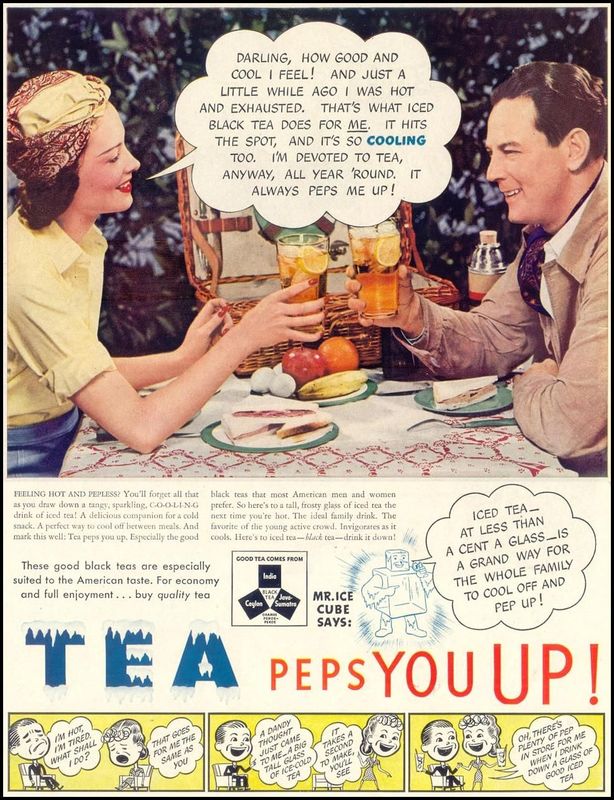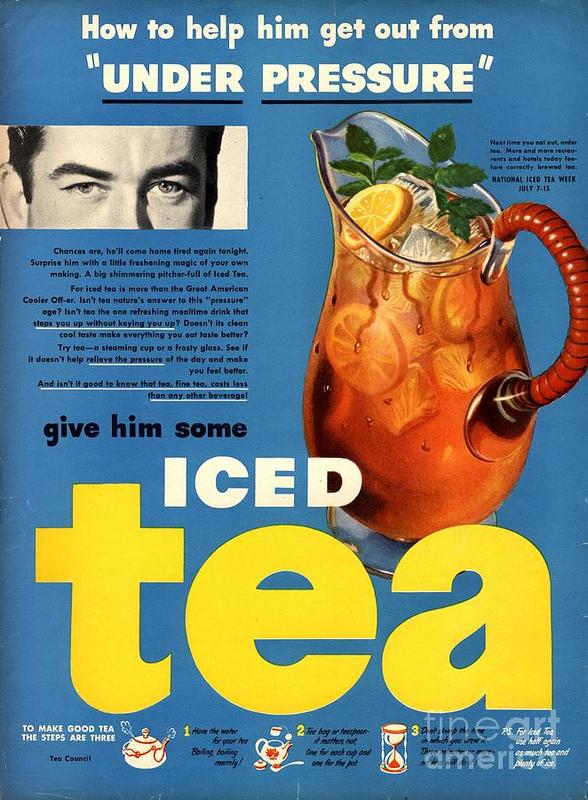1950s: The "Best Years" In American History
The 1950s are often looked at as some of the “best years” in American history, however. Life was not always golden. There were some tensions from the Cold War still present, discrimination was still prevalent, and there was still a large gap between the rich and the poor (Reeves 155). A certain “family image” was encouraged during this era, which included “the bread-winning father, the domestic-minded mother, and three or four happy children living in a single-family home in the suburbs” (Reeves 157). Religion was also greatly revived during this time, where church membership was over 100 million in 1955 (Reeves 158). There is definitely an image the fifties portrays while the underlying problems of the decade are swept under the rug.
Like its 40s counterpart, this advertisement is promoting iced tea as a way for people to pep themselves up. The top image is of a husband and wife sharing a glass of iced tea, with the woman exclaiming that she is devoted to tea all year long. Although the woman is talking about how she was the one who was feeling low energy, she decided to make the tea for both her and her husband as they share a picnic together.
In addition to the image at the top, there is a comic strip at the bottom showing a man and a woman. The man exclaims that he is hot and tired and the wife agrees saying that she is too. The middle panel demonstrates the traditional gender roles of the man sitting back while the woman cooks. The man tells the woman that he wants a glass of iced tea, and she gets up to go make it, exclaiming that it will only take a second to make. Ultimately, both the husband and the wife are happy in the end, saying how much tea peps them up when they drink iced tea. Men in advertisements are often depicted as demanding women to make them food to satisfy their needs, and they have the right to reject them or be angry if those needs are not fulfilled (Parkin 9). The man in the comic strip made a request to the woman to go make a big glass of iced tea, while he sat down and relaxed. Even in the last stript of the comic, the man is still sitting down, while the woman is standing up, showing that she was committed to her role as a housewife. She wants to make sure her husband is happy before she begins to relax again.
The language in this advertisement is intriguing because it all about pleasing the husband after he comes home from work. It plays into traditional gender roles of the 1950s where the husband is the bread-winner worker and the woman stays home and does domestic activities, such as cooking (Reeves 157). The advertisement’s tagline at the top says “How to help get him out from ‘Under Pressure,’” in addition to giving a story about the husband coming home from work. The words “Give him some Iced Tea” is also clearly pictured in large font at the bottom of the advertisement. The advertisement has a simple color scheme, but it is bright and eye-catching. The yellow coloring of the word “tea” indicates that it is the most important part of the advertisement, as it is the product that it is trying to sell.
This advertisement heavily utilizes Parkin’s food advertising theme of women being subservient to men and catering to their needs before they become irritable or angry (Parkin 9). This language suggests that when the man comes home from work, he is stressed and needs to be relaxed by the woman, and making him iced tea will help with his relief. The picture of the man’s eyes next to the iced tea shows a sense of desire and thirst for the iced tea, which further supports the previously mentioned Parkin theme and convinces the female consumer that she must make iced tea to cater to her husband’s needs. The bottom of the advertisement even gives simple instructions on how to make the perfect tea to satisfy the husband. The gender roles presented in this advertisement are highly expressed because of the fifties spotlight of a “perfect” family, where the man works and the woman stays home to cook, clean, and look after the children.


